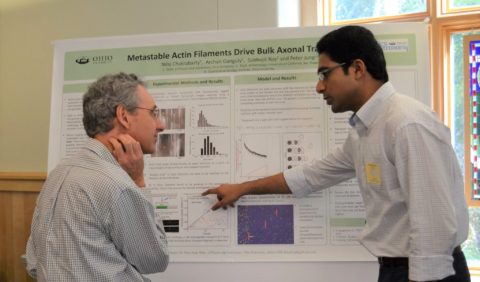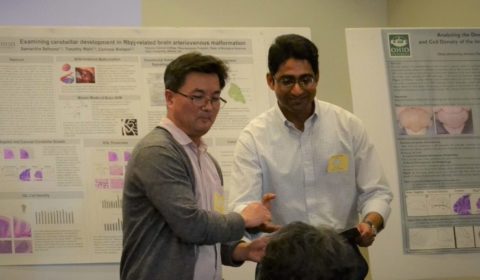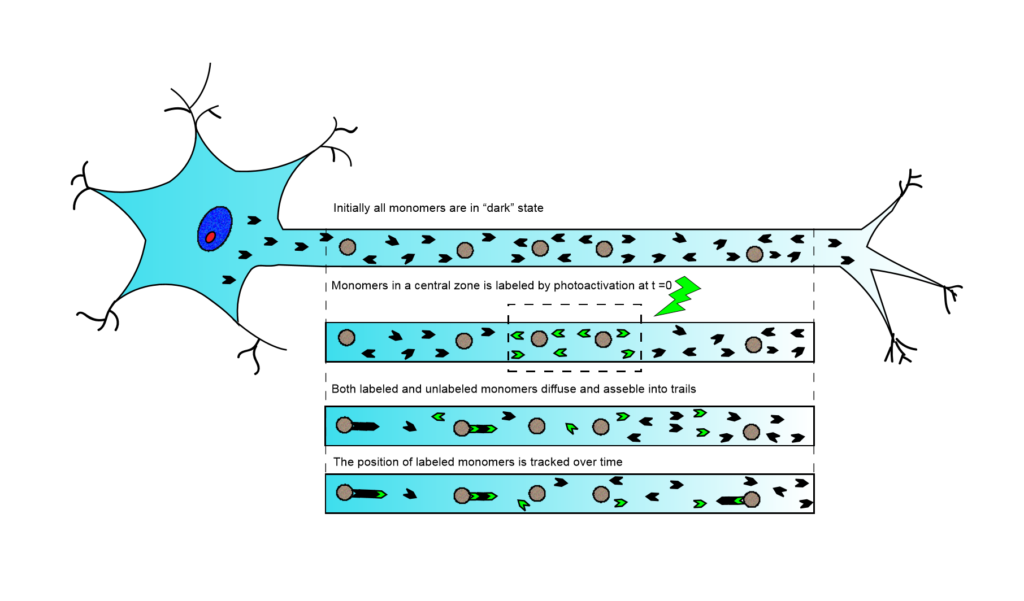
Ph.D. student Nilaj Chakrabarty discussed his work with invited keynote speaker and OSU professor Anthony Brown.
Along the axon of a neuron, the cytoskeletal protein actin plays several important roles in neuron function, including cell signaling and axon elongation. But for years, scientists did not know how actin gets transported from their manufacturing site to their target locations.
Recently, actin was found to generate long, very fast-growing chains called “actin trails.” The role of these trails was unclear, but some researchers hypothesized they serve to enable actin transport.
Nilaj Chakrabarty, a fourth-year Ph.D. student in the Department of Physics and Astronomy, developed a computational model to describe the transport of actin. He was recently awarded first prize for the best overall student poster at Neuroscience Research Day.
Chakrabarty’s group, led by Physics and Astronomy professor Peter Jung, maintains a collaboration with University of Wisconsin-Madison professor Subhojit Roy, who first described actin trails in vitro in 2015. One of the researchers in Roy’s group, Archan Ganguly, earned his Ph.D. in 2012 under the direction of Biological Sciences professor Daewoo Lee.
By incorporating known biological data into a computational model, Chakrabarty demonstrated the functional significance of this process.
“In a cell, you can’t establish a causal relationship (without functional evidence), Chakrabarty said. “We build these structures in a computer model of an axon. (Our collaborators) can give us data about how many chains are formed at a time, how fast these chains grow, and how long these chains grow … We configure our model so that at the end, it will exactly represent their (biological) data.”

Nilaj Chakrabarty was awarded first prize (presented by Daewoo Lee) for his poster at Neuroscience Research Day.

Chakrabarty’s simulation model helped elucidate the functional link between actin trails and actin transport.
Chakrabarty said the model demonstrates that when the growth of actin trails is impeded, actin transport does not occur. Additionally, recent in vitro work has confirmed the findings generated from the model.
Now, the group is working to characterize the regulation of actin trail formation – specifically, regulation of the direction of filament growth. Chakrabarty said trail direction is not absolute, as the model demonstrates that polymerization occurs in both directions. Yet overall, bulk flow trends indicate directionality, or “symmetry-breaking.”
“We don’t understand … why there are more (filaments) growing in one direction than the other,” Chakrabarty said. “It’s something that comes out in the average, but not in the individual. How does a molecule know the right direction to move?”
For more information about Neuroscience Research Day and the Neuroscience Program, visit https://www.ohio.edu/cas/biosci/research/neuro-research.cfm.



















Comments